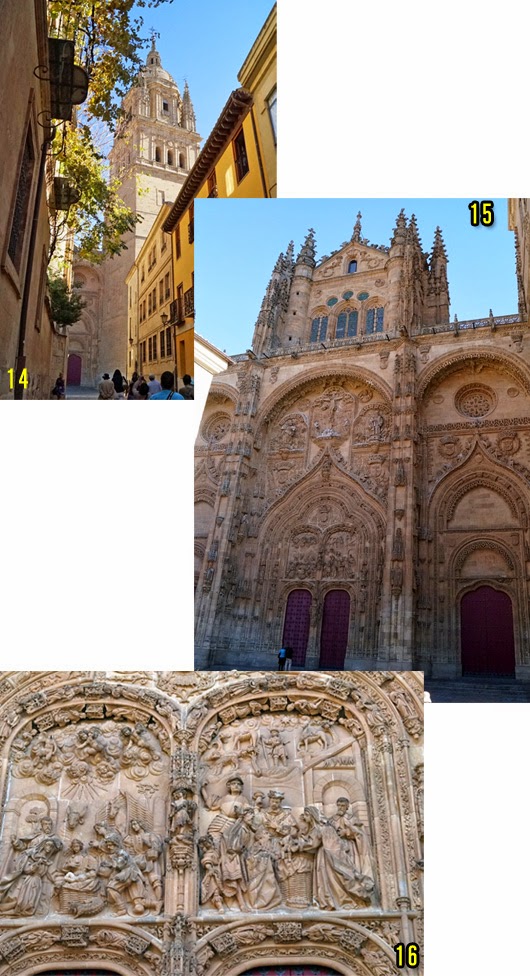スペインとポルトガルを巡る旅 32: 水道橋で知られたセゴビア、スペイン、10月23日
< 1. Aqueduct.
Photographing at 8:00 >
< 1. 水道橋、8:00撮影 >
Today, I introduce the
last sightseeing area, Segovia famous for aqueduct and the castle of Snow
White.
今日は、最後の観光地、水道橋と白雪姫の城で有名なセゴビアを紹介します。
< 2. We had arrived to Segovia on
the previous day >
< 2. 前日、セゴビアに到着 >
Upper photo: We go in Segovia after 10 minutes.
Photographing at 17:55.
Lower photo: A view of the old city from our hotel.
Photographing at 18:35.
上の写真: 後10分ほどでセゴビアに入る。17:55撮影。
下の写真: ホテルから旧市街を臨む。18:35撮影。
< 3. Map: A red line
shows our sightseeing route. >
< 3. 地図:赤線が観光ルート >
The upper part of the
map is the north.
The number of the map
shows the photo number and the photography spot, and is in order of the
photography.
We started from a yellow circle at 7:55,
went uphill and traversed the old city by foot, went downhill, and then arrived
at blue circle, and we finished the sightseeing at 9:40.
At this time, there was not sightseeing
of admission, too.
地図上方が北。
地図中の番号は、写真番号と撮影場所を示し、撮影順序通りです。
7:55に黄丸印を出発し、徒歩で上って旧市街を縦断し、また下って青丸印へ9:40に到着し観光を終えた。
今回も入場観光はなし。
About Segovia
From time immemorial,
this hill was being ruled by Celt, Roman, the Goths and Muslim.
After Christian had forced Muslim out of
this area, and this hill became a castle city of Castile in the 13th century.
This area was a route of
transhumance, and the woolen industry developed, therefore this area soon
entered the golden age.
By a law for the protection of
sheepherder of this time, Spanish people were not able to own cultivated land
for centuries.
In the 16th century, Segovia was
destroyed thoroughly by the revolt that Segovia participated for obtaining the
autonomy of the city together with 15 cities.
However, they accomplished the rebuilding.
This fortress city at
1000 m above sea level is on high hill whose surrounding was hollowed by two
rivers, and is 90 m high from the rivers to the top.
Therefore, the aqueduct
was necessary to supply it with water from the upper reaches.
セゴビアについて
ここは古くはケルト人、ついでローマ人、ゴート人、やがてイスラム教徒が支配した。
キリスト教徒がイスラム教徒をこの地域から追い出すと、13世紀、ここがカスティーリャ王国の王都となった。
ここは移牧のルートにあたり、毛織物産業が発展し最盛期を迎えることになる。
この時の羊飼い擁護の法律により、何世紀もの間、スペインは耕作地を持つことが出来なかった。
16世紀、セゴビアも参加した自治都市権獲得(15都市が参加)の反乱で、ここは徹底的に破壊された。
しかし、彼らは再建を成し遂げた。
この城砦都市は、二つの川で抉られた標高1000の高台(川から90mの差)にある。
したがって上流から給水するために水道橋が必要だった。
< 4. aqueduct and
plaza >
< 4. 水道橋と広場 >
1: plaza having an aqueduct.
2: The highest place of the aqueduct is 29m high
in this plaza.
3: The aqueduct connects with the top of the
castle wall surrounding the old city.
4: Once, the aqueduct had supplied water from distant
mountain of 15 km behind.
The aqueduct was made by
Roman in about the 1st century B.C., and was destroyed by Muslim in
the 11th century.
We are seeing the thing
reconstructed in the 15th century.
1: 水道橋のある広場。
2: 水道橋の一番高い所はこの広場で29mある。
3: 水道橋は旧市街を囲む城壁に繋がっている。
4: かつて水道橋は遠方の山手、15km先から水を供給していた。
この水道橋は紀元前1世紀頃、ローマ人によって造られ、11世紀にイスラム教徒によって破壊された。
私達は15世紀に再建されたものを見ている。
< 5. A street
proceeding to Cathedral >
< 5. カテドラルに向かう通り >
6: We leave the plaza and went up about 20
meters high to Plaza Mayor.
7: As I look down at the south side, I can see an
Iglesia (church) of Romanesque style in the twelfth century.
8,9:
The design of the outer wall is beautiful. Influence of Islam is seen.
6: 広場を後にして、マヨール広場まで20m程上っていく。
7: 南側を見下ろすと、12世紀のロマネスク様式の教会が見える。
8、9: 外壁の模様が美しい。イスラムの影響が見られる。
< 6. Iglesia de San
Martin and street >
< 6. サン・マルティン教会と通り >
10:
Iglesia de San Martin of Romanesque style.
12:
The bell tower of cathedral came in view.
10: ロマネスク様式のサン・マルティン教会。
12: カテドラルの鐘楼が見えてきた。
< 7. Cathedral >
< 7. カテドラル >
This is Spanish last build of Gothic
style, began to be built in the 16th century and completed 240 years later.
It is called "A lady
of cathedral" from the elegant form.
16世紀に建設が始まり、240年後に完成したスペイン最後のゴシック大聖堂。
その優美な姿から「カテドラルの貴婦人」と呼ばれる。
< 8. Plaza Mayor and a
street market >
< 8. マヨール広場と露天市 >
The market was opening
in Plaza Mayor in front of the cathedral.
It had aimed to not tourist but
citizens.
I looked for books in a secondhand
bookstore, but there unfortunately was not the thing that I wanted.
カテドラルの前のマヨール広場で市が開かれていた。
観光客目当てではなく市民向けの市でした。
私は古本屋を物色したが、欲しいものが無く残念でした。
< 9. Alcazar >
< 9. アルカサル >
The castle became the model of "the
castle of Snow White" of Disney.
It was made in the eleventh
century on fortress remains of the Roman era, and became the
form like the present in the 15th century, but it was restored after a big
fire.
This castle was built on the cliff of 60
m in height that was sandwiched by two rivers.
ディズニーの「白雪姫の城」のモデルになった。
城はローマ時代の要塞跡に11世紀に造られ、15世紀に現在のような形となったが、大火後修復された。
この城は、二つの川に挟まれた高さ60mの崖の上に建っている。
< 10. Iglesia and
Alcazar >
< 10. 教会とアルカサル >
18: A church of Romanesque style in the twelfth
century.
21: Iglesia de la Vera Cruz of an unusual
dodecagon.
When I looked down, the
small church was seen in the wasteland of the north side.
The Knights Templars
(defend Jerusalem) built it in the 13th century, and the crucifixion cross of
Christ is preserved.
22: we went down steep stairs along the cliff
from the Alcazar, and we photographed from an open space.
18: 12世紀のロマネスク様式の教会。
21: 珍しい12角形のラ・ベラ・クルス教会。
見下ろすと、北側の荒野に小さな教会が見えた。
これはテンプル騎士団(エルサレム防衛)が13世紀に建てたもので、キリストが磔にされた十字架が保存されている。
22: アルカサルから崖に沿って急な階段を降りた広場から撮影した。
< 11. I say good-bye
to Segovia and Iberian, “Sayounara!
Adios! Adeus!” >
< 11. セゴビアとイベリアに別れを告げて、さようなら! アディオス! >
I finish the last
sightseeing and, in the afternoon of this day, return home from an airport of
Madrid.
I am blessed
with beautiful weather in spite of rainy season and am parting with the sun and
the town of the Middle Ages now.
From the next time, I
write down Barcelona and Antoni Gaudi(Sagrada Familia), the Prado
Museum of Art (Madrid), and
shopping information.
最後の観光を終え、この日の午後、マドリッドの空港から帰国する。
雨期にも関わらず快晴に恵まれ、これで太陽と中世の都ともお別れです。
次回から、バルセロナやプラド美術館、ガウディ、ショッピング情報などを記します。

































